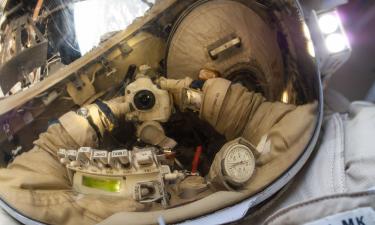Nuclear Traction Engine To Take Russian Spacemen to Mars
Vitaly Lopota, the head of Russia's Energia Space Corporation, reported when and how Russian spacemen would travel to Mars.

In the past few years it seemed like Russia was ready to accept its role as a space power number two. Americans are building a new spaceship and packing their space suits for the Mars expedition, while Russia is modernizing its Soyuz yet again, built over 40 years ago. Like true cab drivers, Russia gives rides to the International Space Station to everyone who pays.
At the 34th academic readings devoted to space issues held in Bauman Moscow State Technology University in memory of Sergey Korolyov, Vitaly Lopota, president and chief engineer of Energia Space Corporation, made an astonishing statement. He presented a clear, balanced and modern development plan for Russian pilot-controlled space technology. The plan included deadlines, a well-thought strategy and weak points (which is particularly plausible, since otherwise the plan would sound like an arrogant attempt at success rather than an engineering plan).
The International Space Station (ISS) is the most expensive project in the world. Participating countries have already invested 120 billion dollars into it. Even wealthy Americans had to tighten their belts and first abandon their shuttles (this year), and then their Moon program (the Congress recently cut the program’s budget).
No one is planning to close the ISS in 2015 as it was intended 10 years ago because the money has been already paid. The station is finally fully equipped. Last week the Americans attached the new wing called Tranquility to it. Its seven illuminators provide the view of the ISS and Earth.
It was decided to keep the station until 2020. There are talks, however, that the station will be hanging in orbit until 2028 or even longer. Why not? It could be turned into the base for preparing interplanetary expeditions. Old, worn out modules could be replaced with new ones.
There is a danger for Russia to get bogged down in this project. Even if Russia builds a new ship, we might still remain a mere space cab driver while replacing Soyuz with Rus’. Then we will be number two for sure. Many experts I talked to were concerned about this issue. And then, Lopata made his crucial statement.
The Russian pilot-controlled program will develop concurrently with Rus’ and rockets for in-orbit delivery.
In the 50 years of space era the humanity learned very well how to deliver cargo to low earth orbit. Bringing 20 to 30 tons 300 to 500 kilometers above Earth does not pose a problem. But this is what the experts call the “stopover technology” (throwing a satellite in required orbit and burning the fuel).
What about traveling to Mars? How much rocket fuel – oxygen, hydrogen, and kerosene - is required for a spacecraft traveling to Mars? Imagine that an entire house would have to be sent to the Red Planet. The team has to be provided with all necessities. Plus , life support systems must be duplicated .
A person requires on average 22 pounds of resources to survive one day, including food, water, air and clothes. A team traveling to Mars consists of minimum four people.
“ Two people team means a potential conflict . Three people team means a conflict of two against one. Four people are the required minimum,” Lopota explains.
This means that 88lbs of cargo is required per day. It takes approximately 8.5 months to fly to Mars, and another 8.5 months to fly back, plus the time spent in orbit. Experts calculated that a spacecraft travelling to the Red Planet must weigh 500 tons. The ISS is now half of this weight.
“The way out is nuclear energy,” states Lopota.
This means that nuclear power rather than a rocket engine should pull a spacecraft headed to Mars.
Spacecrafts with nuclear engines are not just a dream. Back in the 1970s, the Soviet Union launched nuclear powered satellites. Recently a federal program “New generation of nuclear energy technologies for the period of 2010 - 2015 and up to 2020” was approved. This year, 500 million was allocated for creation of transport-power module based on nuclear energy.
According to Lopota, the first nuclear power spacecraft can be launched by Russia in 2017. This means that by the end of the decade, if all works out, we will have both a new manual spacecraft and new energy system.
Vitaly Lopota is convinced that Russian spacecrafts will be built from modules. Nuclear power can be used as a basis for a universal platform capable of solving a number of issues, including those outside of low earth orbit. It could serve as a cargo delivery vehicle (for example, to the Moon) or as a base for telecommunication satellites or even a special trawl for collecting space litter. It could also serve as an interplanetary interceptor capable of eliminating asteroids posing a threat for the humanity.
Engineers suggest using the same platform as the basis for the Mars expedition complex.
“By 2020 - 2025 Russia will have a base for assembling interplanetary spacecrafts in orbit,” Lopota is convinced.
The project will employ the piloted capsule Rus’, storage modules, and scientific labs. In orbit these components would come together as a Mars complex. The complex will not have to be built for one flight only. Its structure will depend on its task . One type of structure would be assembled for traveling to asteroids and other type would be assembled for delivering cargo to low earth orbit.
In the 1960s, a trip to the Moon was a new American national idea. America’s feelings were hurt by Gagarin’s flight. These hurt feelings helped the country to create a unique technology for the Moon trip. It was the Moon project that has advanced the American science and technology. The advancement of the 1960 made the USA the intellectual world leader that produces top notch technologies.
Komsomolskaya Pravda
Subscribe to Pravda.Ru Telegram channel, Facebook, RSS!


